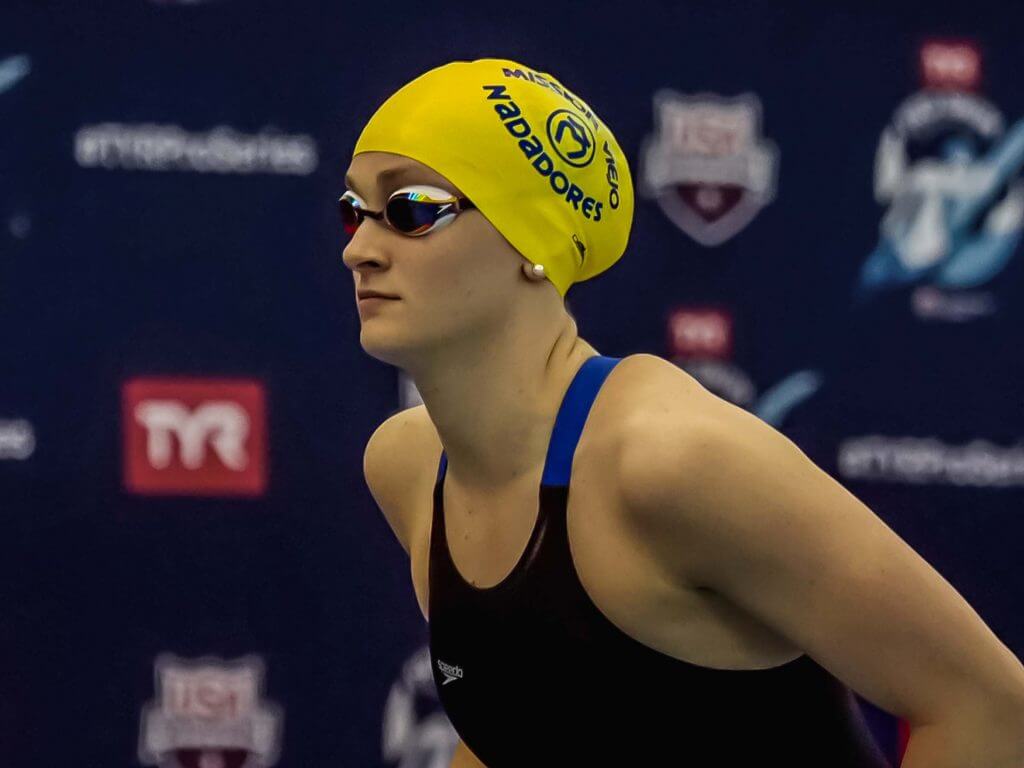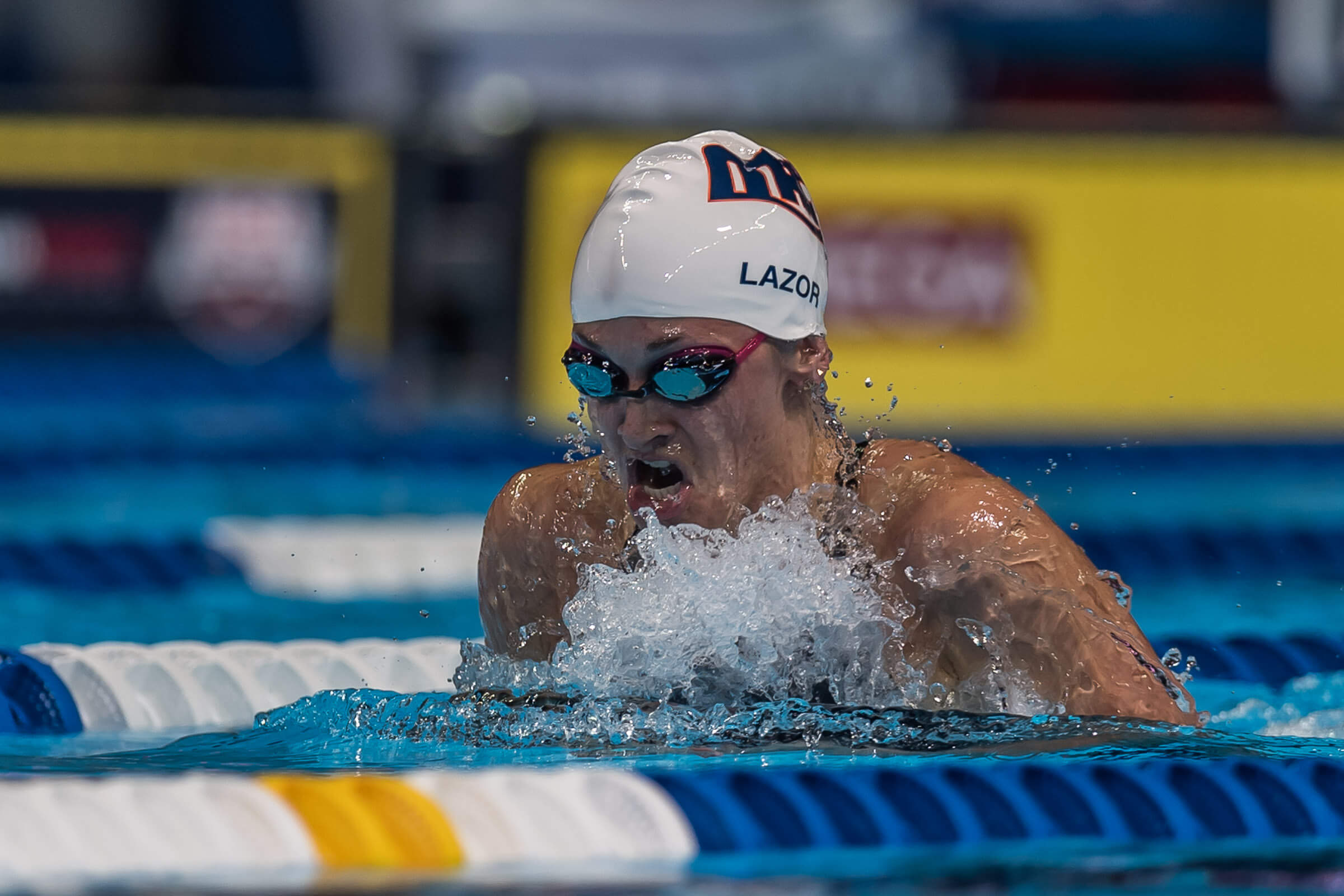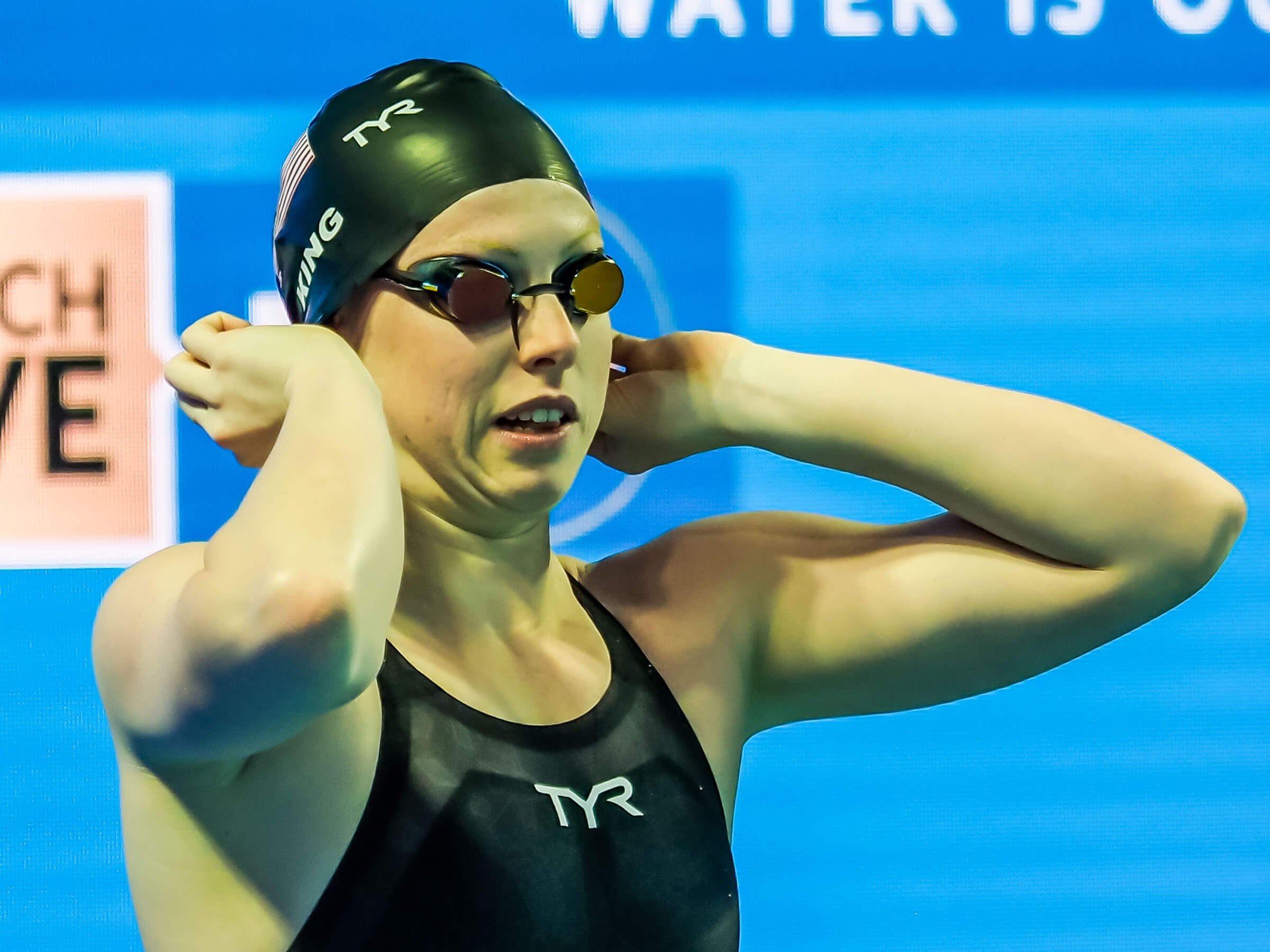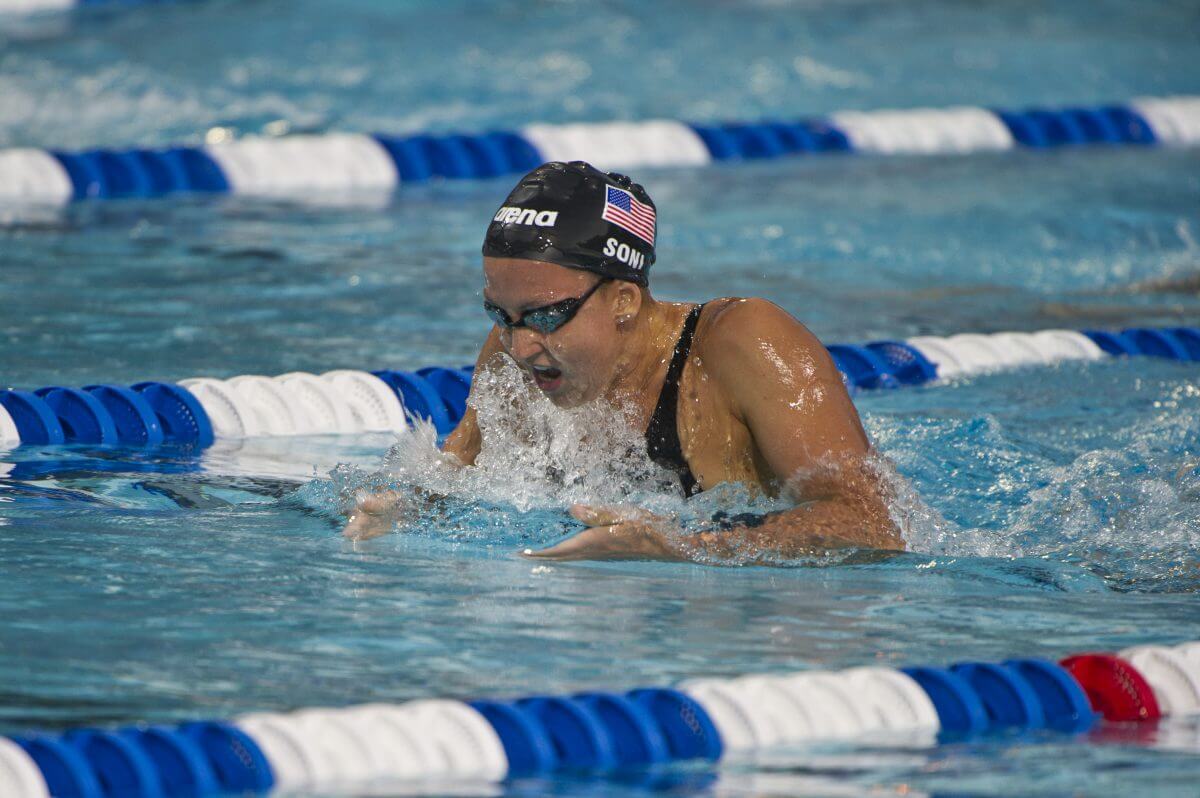Annie Lazor Erases Limits in Stunning Second Act

Weeks after she swam the signature race of her career, Annie Lazor cannot remember much from those two minutes, 20 seconds of the 200 breaststroke that Sunday evening in Bloomington, Indiana. It’s the reaction of her oft-stoic coach, Mike Westphal, that she can’t get out of her head.
After that race, Lazor watched a video of Westphal, the associate head coach at Indiana, “hitting like a two-foot vertical when I touched the wall.” And then, when she approached Westphal on the side of the pool, “he just gave me a huge hug and had tears in his eyes.”
That’s because Lazor had just delivered the kind of performance that swimmers dream of, the once-or-twice-in-a-career sort of swim rather than the once-or-twice-a-year type. At a meet of relatively little consequence, a mid-May TYR Pro Swim Series, Lazor cut two seconds from her lifetime best to win the race in 2:20.77. Before the year, the 24-year-old from Detroit had never even swum under 2:24.
“Mike was just like, ‘I’m just so proud of you,’” Lazor recalled. “I’m like, ‘I made it. I can retire now. I’m done. This is it.’ That was a really cool moment for me.”
For years, Lazor had existed as a solid, national-level breaststroker that never quite stood out from the crowd. She had qualified for semi-finals in the 200 breast at the 2012 Olympic Trials before becoming a steady performer over a four-year career at Auburn. She made her international debut in 2015, winning bronze in the 200 breast at the Pan American Games.
In 2016, Lazor finished seventh in her signature event at Olympic Trials, more than two seconds slower than her season-best time, and as far as any outsider could tell, that was it for her swimming career. Lazor seemed to have fallen victim to the cruel nature of Olympic selection and the massive tension of that meet, a quandary dozens of swimmers face each Olympic cycle.
But looking back now, Lazor believes that what derailed her Olympic dreams that summer was a difficulty that hundreds of swimmers around the country face every year: She had lost her coach.
Rebooting a Career
John Hargis had been Lazor’s primary coach during her last two years at Auburn. It didn’t matter if some other coach could write similar sets or dole out essentially the same advice—Hargis was her coach and the man she wanted guiding her through in the last months before Olympic Trials. But in April 2016, Hargis left Auburn for a head-coaching position at the University of Pittsburgh.
“Obviously, there are certain ways you can handle it, and I was super crushed by it,” Lazor said. “Honestly, it was really hard for me to get out of that.”

Lazor at the 2016 Olympic Trials — Photo Courtesy: Peter H. Bick
When she finished her academic semester a few weeks later, Lazor moved to Charlotte to finish her Olympic preparations with David Marsh’s pro group. In May, she posted a 2:24.96 in the 200 breast, her lifetime best at the time and the fifth-best time by any U.S. swimmer heading into Olympic Trials. But in the Trials final six weeks later, Lazor swam more than two seconds slower.
“I just don’t think I was in the right headspace after everything that had happened to make the team,” Lazor said. “I kind of felt like for a while that swimming had kind of betrayed me a little bit, just in the events that led up to Olympic Trials. I felt like I was ready, and I just felt like everything went wrong. I could have handled it so much better, but I didn’t. I was 21 years old, and I just felt like that was the end of my world.”
At that point, Lazor never officially retired, but she left swimming with no intention to come back. She returned to Auburn to finish her degree and then took a job in athletics operations at Cal-Berkeley, an experience that thinks “helped shape a more mature version of myself and a more cultured version of myself.”
And she considered some advice she had received months into her pseudo-retirement: “Give it a year, and if there’s any part of you that wants to come back, you should.”
Sure enough, during the summer of 2017, part of Lazor wanted to return to swimming. So she moved to Pittsburgh and resumed training with Hargis, beginning the arduous process of getting back into swimming shape. After several months, Lazor and Hargis decided together that she should be training with other professionals of her caliber.
“And that’s how I ended up at Indiana.”
Learning to Dream Big
When Lazor reached out to Indiana head coach Ray Looze about joining the Hoosiers’ training group, Looze consulted Indiana’s resident stud breaststroker, a notoriously audacious Olympic gold medalist. And Lilly King told her coaches that, yes, she wanted Lazor to come to Bloomington and become her training partner.

Lilly King — Photo Courtesy: Peter H. Bick
“I wouldn’t be here if it wasn’t for Lilly,” Lazor said. “Honestly, given what I thought I knew about her prior to that, I was pretty surprised. Lilly, obviously, has somewhat of a reputation. I would think if it were my competitor and she had this program that’s working really well for her, why would you want to share that with her other competitors?
“I think by her telling them that I could come here and she wanted a training partner, that speaks volumes about the kind of athlete that she is.”
Lazor came to Bloomington having already worked her way back into shape, but she initially struggled to adapt to the increased volume and tough breaststroke workouts she was assigned. She found herself often physically exhausted but also energized by “just being around other people who are doing what I’m doing and being in environment where truly everyone wants to be the absolute best that they can be.”
Finally, Lazor remembers arriving with the attitude of, “Let’s see how good I can get.” A best time at Summer Nationals? That would be cool, she thought. Making the Olympic team or any international team? Not in the forefront of her mind.
At Nationals, Lazor surprised herself—and just about everyone else—with a third-place finish in the 200 breast and a lifetime best by a half-second (2:24.42). Lazor expected that the result would earn her a spot at the Pan Pacific Championships, her first meet with the senior U.S. national team.
But the 200 breast came on day two of a five-day meet, and Lazor would still need more swimmers to qualify in multiple events to earn the spot. In the end, she would be shut out. Even after she arrived in Irvine with no expectations of a trip to Tokyo, the possibility of Pan Pacs got her hopes up—and the ensuing letdown got her competitive juices flowing again.
“I kind of tasted the opportunity to maybe get to go to Pan Pacs, and people said, ‘Oh yeah, you’re for sure going to go. They always take third place,’” Lazor said. “And then I ended up not going. I felt that hurt. I felt that competitive pain. Looking back on it, it taught me not to put a limit on what I’m going to do or what my goals should be or what teams I should make.
“Maybe if I hadn’t placed that limit on myself, maybe things would have been different.”
A Year When Everything Goes Right
The Indiana coaches warned Lazor before she arrived that it might take a year before her body was fully adjusted to the training program. Perhaps in 2019, Lazor has successfully adapted and figured out how to unlock potential that lived inside her all along. What’s clear is this: Lazor has put together by far the best season of her career.
The hot stretch began in December, when Lazor upset fellow American Bethany Galat to win gold in the 200 breast at the Short Course World Championships in Hangzhou, China. Immediately after, Lazor went on a hot streak that none could ignore.
Consider these performances in the 200 breast: At the first TYR Pro Swim Series meet of the year in Knoxville, Tennessee, Lazor won the 200 breast in 2:23.51, a lifetime best by almost a second. She won again seven weeks later in Des Moines, knocking her best time down to 2:22.99, before coming close to that mark in Richmond with a 2:23.22.

2012 Olympic gold medalist Rebecca Soni — Photo Courtesy: Peter H.Bick
All of that, of course, was a prelude to her 2:20.77 in Bloomington in May, a swim which made Lazor the ninth-fastest performer in history. Among Americans, only Rebecca Soni has swum faster—yes, the same Soni who became the first woman to ever crack 2:20 back at the 2012 London Olympics and then retired immediately thereafter.
To reiterate: No American woman has swum as fast as Annie Lazor has in the 200 breast in the past seven years.
When Lazor learned of her newly-acquired place in history, her voice rang with surreal pride.
“I remember when I was 13 years old watching Olympic Trials with my mom and just watching Rebecca Soni on TV and just being blown away. And even in 2012, I swam with her in my first Olympic Trials in the semifinal when I was 17, and I was just, like, internally freaking out,” Lazor said. “It just brings a smile to my face to even be in the same sentence as her. You know what I mean? It sounds so childish, but it’s true.”
Coinciding with her epic rise in the 200 breast, Lazor’s 100 times have dropped to a world-class level. Entering 2019 with a lifetime best of 1:07.79, she has swum in the 1:06-range on four occasions this year, including a 1:06.03 at the Bloomington meet that ranks ninth all-time among Americans.
Looking Up at Lazor
So what exactly has been going so right? “I’m still trying to figure it out,” Lazor said.
“It sounds so cliché, but it’s true—I just have given it all to Mike and Ray. I’m just so grateful to be here and grateful that they have taken me and that they saw potential to me. That’s all I’ve really done—taken advantage of the opportunity that I’ve been given.”
Two weeks after Bloomington, King raced the 200 breast against Russian rival and defending World Champion Yulia Efimova at the FINA Champions Series in Indianapolis. King would edge out Efimova, 2:21.39 to 2:21.58, improving her all-time rank in the event to third among Americans behind Soni and, yes, Lazor.
Lazor won’t be at World Championships this summer, but King, Efimova and the rest of the world’s best in that event will have their eyes on the Pan American Games in Lima, Peru, to see what sort of time Lazor can throw down. Lazor earned that extra attention and even respect with her performances all season.
Perhaps most importantly, after crushing any expectations she had for herself in this entire comeback, Lazor has figured out how to not put limits on what she believes she can accomplish. Her entire year and particularly that 2:20 have “started to let the wheels turn in my mind.”
“I’m a competitive person. It’s hard not to think about those things,” Lazor said. “It’s hard not to think about how much better I can get. But at the same time, too, just keeping that mindset of, ‘Let’s see how good I can get,’ I think that’s what got me here in the first place and not putting a limit on what I’m going to do. I think if I keep thinking that way, it will bring me beyond limits I could have ever imagined.”



